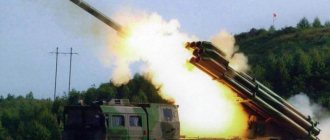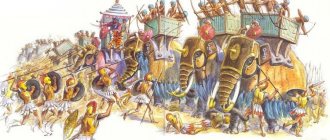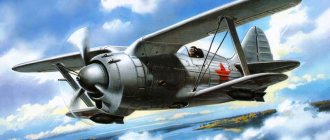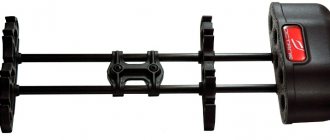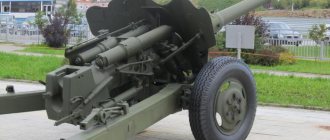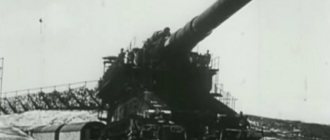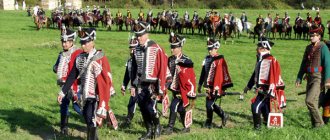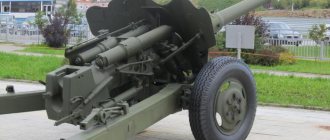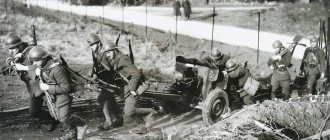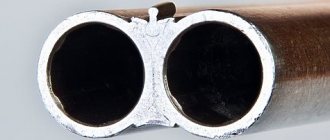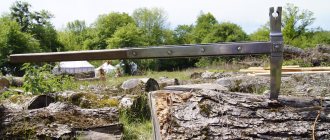Asian background[edit]
distant ancestor of the Katyusha, ancestor of cruise missiles
After the Chinese invented gunpowder, it was used for a long time mainly as a weapon, and they could not make a formidable weapon based on it. However, in the 13th century, China already knew artillery guns and wrote treatises on their use (it was this century, or rather 1288, that the oldest bombard in the world, of course, made in China, was dated).
In the same thirteenth century, gunpowder and cannons were borrowed from the Chinese by the Arabs. The first documented use of siege artillery by the Arabs was in 1274, the siege of the city of Sijilmas.
The penetration of gunpowder into Europe dates back to approximately the same century. Gunpowder, but not how to use it. The first cannons in Europe appeared in Spain, borrowed from the Arabs, at the turn of the 13th-14th centuries.
Military rockets were also invented in China.
The prototype of the hand gun was the “fire spear,” which was the Chinese version of the hand flamethrower.
Bombard, culverin, falconet - the first European guns[edit]
The first types of gunpowder artillery manufactured in Europe were the bombard and the culverin.
- The bombard
was a massive piece-made siege muzzle that fired heavy stone cannonballs with a caliber of about 500-800 mm.
They didn’t know how to cast artillery well back then, so bombard barrels were forged from iron strips and hoops. This design had little safety margin, so forged bombards were dangerous not only for the enemy, but also for the gunners themselves. The bombards did not have any carriages; they were only bare trunks, and each time they were used, fixed stocks were built for them. Basilisk
- replaced the bombard in the 15th-16th centuries. Unlike the short, pot-bellied bombard, the basilisk was long-barreled and large-caliber. It already had a wheeled carriage, which made it easy to transport. - The last bombard of Europe is the notorious Tsar Cannon
, which never fired: the absence of a pilot hole and the internal chamber of the barrel not cleared of flash guarantee this. In terms of manufacturing technology, it is a transitional form between a bombard and a basilisk, already cast and long, but in terms of purpose it is a typical bombard. The Tsar Cannon, like other bombards, did not have a carriage; the famous gun carriage on which it stands in the Kremlin is pure props of later manufacture.
was a medium-sized cannon, similar to a small bombard, and made using the same method of forging and hoop-hooping. Since these hoops or rings were quite thick, this gave the culverin a characteristic "ringed" appearance. The first culverins were small cannons, carried by 2 people, with a caliber of 20-30 millimeters, and were used as “anti-tank guns” against knights. Then, from small culverins, hand guns - arquebuses - evolved, and large ones began to increase in size; the typical caliber of the late 16th-century culverin is 80-140 millimeters, the projectiles are iron or stone cores. In Rus', the culverin, like the arquebus, was called the “arquebus.”
is almost the same as the early culverin, a small cannon with a caliber of 20 to 60 mm, carried by a crew of 2-3 people. When the name “culverin” was assigned to medium-sized guns (and this was already the 16th century), small ones began to be called falconets.
is a very unsuccessful design of a European cannon of the 14th-15th centuries, it looked like a narrow-necked pot-bellied vase, into the neck of which a short arrow was hammered, which served as a projectile. It was used in France and Italy, the name itself translated from French means “iron pot”.
, or
tyufeng
, was a medium-sized cannon that fired stone shot and was used in the Golden Horde and Russia. In Europe there were similar ones, but they did not have a special name. The mattress was an anti-personnel weapon; it was used to hit concentrations of manpower, which it cut with its stone shotgun.
,
organ
,
magpie
- a multi-barreled gun consisting of a dozen or more large-caliber muskets firing a salvo. In the Turkish version, all these barrels were drilled inside one barrel, like a large-caliber gun. It fell out of use after the spread of buckshot.
For the first two centuries of the existence of gunpowder artillery in Europe, it was under the jurisdiction of special city gunner guilds. In other words, the artillerymen had the status of free burghers-artisans, and not bollards or even city militias, and were an autonomous and part of the already autonomous city army, which did what it wanted and did not swear allegiance to the feudal lords. And if some feudal lord needed artillery preparation before storming the castle, he needed to grease the gunners very well so that their convoys would go where they needed to. But with the appearance of the first rudiments of regular armies, the kings quickly created their own artillery in their service, and the guilds of gunners faded into the background, and were soon completely consigned to oblivion.
Russian artillery: from mattresses to rifled guns
used stone-firing cannons for the first time during the siege of Moscow by the Golden Horde Khan Tokhtamysh This date is considered the day of the birth of Russian artillery, which in a short time by historical standards became a formidable god of war.
Forged mattresses
is a huge difference between the cannons that the warriors under the command of Prince Ostei The only thing they have in common is that both use the energy of powder gases.
The first Russian cannons, called “mattresses” or “firearm outfits,” were made in a handicraft manner from sheets of wrought iron, which were joined by forge welding on a wooden cylindrical blank. The trunks were strengthened on mobile wooden machines. The barrel was loaded with gunpowder and stone cannonballs. On the shelf at the back of the barrel, where a hole was drilled, the gunpowder was ignited.
The firing range and accuracy were low. Which at that time was not so important, since mattresses were used either in contact with the enemy or during the siege of fortresses. Here, first of all, the power of the shot was required, which was sufficient to destroy defensive structures and cause significant harm to cavalry and infantry.
Read on topic
Russian brigades remember the Galician fields How the Southwestern Front drove the Austro-Hungarians from Zolotaya to Gnilaya Lipa
There are no battle details of the defense of Moscow from Tokhtamysh. However, it is known that the Horde could not take the city by force of arms, which, undoubtedly, is the merit of the firearms. The Muscovites, having bought into the khan’s cunning, opened the gates themselves, to their own misfortune.
An invention that was remembered after 250 years
A breakthrough in bombardment came when the technology of casting copper and bronze appeared at the end of the 15th century. The new guns not only had a significantly longer service life, but also allowed for more accurate and longer-range shooting. Under Ivan III , the grandfather of Ivan the Terrible, a cannon hut was founded in Moscow, in which at first Russian craftsmen learned the art of casting cannons of various calibers from the Germans and Italians. Soon the art was fully comprehended, and a galaxy of talented Russian gunsmiths was formed. The most famous of them is Andrei Chokhov . Among his many, one can safely say, creations is the famous “Tsar Cannon”, installed in the Moscow Kremlin.
Under Ivan the Terrible , technology continued to be improved and the production of guns increased. A new type of military force was also created - artillery. Giles Fletcher , who visited Moscow 4 years after the death of Ivan Vasilyevich, described the legacy of the formidable tsar in terms of artillery as follows: “It is believed that none of the Christian sovereigns has such a good supply of military shells as the Russian tsar, which can partly be confirmed by the Armory A chamber in Moscow, where there are huge numbers of all kinds of cannons, all cast from copper and very beautiful.”
Under Grozny, separate artillery units were created and staffing was determined: two gunners were assigned to each gun, who were assigned tax-paying people for servants - from three to five people, depending on the caliber. The gunners formed a special guild and received large salaries. At this time, the first work on artillery appeared in Russia - “Charter of military cannon and other matters related to military science,” compiled by gunner Onisim Mikhailov.
In the 16th century, artillery took part in all military campaigns of the Russian army. She played a major role in the Livonian War, where fortresses were taken thanks to the valor and excellent training of the gunners. And her participation in the capture of Kazan in 1522 cannot be overestimated. During the siege of the fortress, 150 heavy guns were used, which bombarded the fortress walls for a month. And only thanks to this, the army of Ivan the Terrible was able to occupy the city.
At the beginning of the 17th century, Russian craftsmen made a arquebus, which anticipated the further development of artillery pieces. Its barrel had ten spiral grooves inside. The shooting was carried out with oblong shells. In this case, the gun was loaded from the breech side due to the fact that a wedge-shaped bolt was used. There was also an option with a screw-on bolt. The use of a rifled barrel made it possible to significantly increase the accuracy and firing range. Subsequently, two and a half centuries later, when rifled barrels became the “norm of life,” statistics showed that they are 5 times more accurate than smooth-bore ones and 3 times longer-range.
However, this was a “prototype”; this gun design did not go into mass production at the time. In this connection, it is generally accepted that the French were the first to use artillery pieces with a rifled barrel in 1859. The Russian army switched to them only 10 years later.
But we had guns with unitary ammunition, that is, with modern shells, 10 years earlier than in other countries. This happened in 1875 thanks to the work of engineer Vladimir Stepanovich Baranovsky .
The transition from art to rigorous science
A significant breakthrough in artillery was made by Peter the Great, who, through the window cut into Europe, introduced important organizational measures to the fatherland. First of all, he put the production of weapons, including artillery pieces, on an industrial basis. By his order, state-owned cannon factories were created, where a division of labor by specialty was introduced. This made it possible to produce a series of guns that differed minimally from each other, both in quality and in manufacturing accuracy. Making a cannon became not an “act of art”, but a purely mechanical matter, all operations of which were brought to automation. Of course, drawings were used, the compliance of which was monitored after each production operation.
Another merit of the Russian emperor is that he standardized and unified the calibers of guns. Before him, in fact, each cannon fired shells specially made for it. He sharply limited the number of calibers. The largest were intended for siege weapons. He proposed to the designers of all other guns to dramatically increase their mobility and maneuverability. Regimental and field guns were required to keep up with the infantry and repeat their maneuvers. But there was also cavalry, which also urgently needed artillery support. Therefore, horse artillery was established, which was equipped with light and powerful cannons. All gun personnel moved in the combat zone on horses.
The division of artillery into four types depending on the assigned tasks was big news for Europe, which looked with interest through the “window” to see what the young and ambitious Russian Tsar was doing. Half a century later, the Prussian king Frederick II borrowed the structuring of artillery from the Russians. Later it was introduced in other Western European countries.
Largely thanks to the artillery reform, Peter won resounding victories on the European battlefields. The most characteristic in this regard was the Battle of Poltava in 1709.
Read on topic
Gold Rush in Russian How the prospectors of Siberia differed from the Americans of the Klondike era
Having repelled the night attack of the Swedes, the Russians formed a battle formation. Artillery was placed ahead of the infantry. She began to mow down the enemy with grapeshot, who again tried to overthrow the army of Peter the Great. 70 guns took part in the shelling. The enemy had the opportunity to respond with only four combat-ready cannons.
The Swedes, suffering heavy losses, tried to quickly pass the shelled area in order to get into hand-to-hand combat. When they succeeded, Peter ordered the fire to be transferred to the second line of Swedish troops, built behind the first line. The fire was just as intense, but they were firing cannonballs. The second line of the Swedes suffered heavy losses and at the right time could not support the troops of their first line.
The job was essentially done. Menshikov's cavalry brought into battle turned the enemy into a disorderly retreat.
Field artillery of the New Age[edit]
Throughout the 16th century, the above types of artillery were used, with a clear bias towards siege mortars and light “fortress guns”, respectively, for the assault and defense of fortifications. There were practically no meaningful tactics for using artillery in the field.
In the 17th century, after the crisis of the genre, artillery was revived, however, in a new format: the Swedish king-commander Gustav II Adolf invented field artillery and tactics for its use. This king was generally full of innovations in military affairs; the regular conscript army of the linear system was also his invention. Light artillery pieces were introduced into the infantry, at a rate of one per battalion, and infantrymen were trained to maintain and transport them.
The artillery of the linear era, which began with the army of Gustavus Adolphus, had the following varieties:
- The field gun
is of medium size, light enough to be transported, if necessary, by the muscular efforts of soldiers without the help of draft horses, on a carriage. It could fire three main types of ammunition: a cast-iron cannonball, a grenade filled with gunpowder, and buckshot. There were also more exotic ammunition: firebrands (incendiary cannonballs), luminous (tracer) cannonballs and others. - A howitzer
is a shorter and larger-caliber weapon, for firing mainly explosive and incendiary ammunition along a mounted trajectory, rarely with grapeshot, but in which case the howitzer could fire like a cannon.
Unicorn
is a Russian type of howitzer, the distinctive feature of which is that it could be used both as a cannon and as a howitzer.
is a short-barreled, thick-walled pot that fires only with explosive and incendiary projectiles and in a steep arc; the range was determined by the angle of elevation and the weight of gunpowder. To use it, matan was required in elephant doses, and in the case of the fleet, also special ships capable of withstanding a monstrous load, because this garbage weighed a lot and kicked very hard (when fired, the ship plunged into the water from the recoil at least a foot , and then jumped back out of the water just as much). The range exceeded all conceivable limits, which was valuable when bombing forts and fortresses, but the slowness and low accuracy made it almost impossible to fire at maneuvering targets. During all the time of naval battles from the 15th to the 19th centuries, it was possible to hit an enemy ship from a ship’s mortar exactly once!
is a small-caliber ship's cannon on a special hinge (swivel) instead of a carriage. On warships it played a very auxiliary role, and on some merchant ship it could be the only artillery armament (if there was no money for normal guns, or they were stupidly greedy). When landing from a ship ashore, these guns were often taken as the lightest. These guns could also be used as auxiliary guns in the defense of fortresses.
is primarily a naval weapon; it was practically never used as a field weapon. It appeared when tacticians realized that picking at battleships with conventional cannons was too time-consuming and boring. The idea was as follows: the caronade shoots a very heavy low-speed cannonball, of course, at a slight dislocation. The point of this ammunition is that it does not pierce through a battleship, like cannonballs, but breaks through the sides, causing monstrous damage to the plating, frames and, most importantly, to the enemy crew - wood chips acted as a means of destruction, incapacitating the crew not worse than buckshot. The second purpose of the caronade was to fire bombs - in this capacity, the caronade could shoot much further (since the bomb is lighter than the cannonball), and the damage was greater due to the high-explosive effect of the projectile getting stuck in the pine sides. At the Battle of Trafalgar, Admiral Nelson's flagship Victory fired a volley of grapeshot from carronades at the French, and the Russian brig Mercury, in a battle against two Turkish battleships, fired at them from carronades with nipples. Caronades, due to their caliber, were placed mainly on the lower gun deck. However, the lighter weight (due to the shorter barrel length) made it possible to place carronades on the upper deck.
A simple and terrible weapon
Military historians have estimated that during the First World War, losses from mortar fire amounted to at least 50% of all ground forces losses. It can be assumed that in the future this percentage only increased.
German mortar of the 16th century, cast together with the pallet
Who invented the first mortar and when? Alas, no one knows this. The ancestor of the mortar was the mortar. In any case, the first guns that threw projectiles along steep trajectories (60°-80°) appeared no later than the 15th century. These mounted fire guns were very short (1.5–3 calibers long), since it was difficult to insert a projectile and charge into a long channel with a high muzzle position. Such a weapon resembled a mortar in appearance, which is why it received the name mortar (müser in German and mortiere in French means “mortar”).
Mortars fired cannonballs, grapeshot, small stones placed in wicker baskets, various types of incendiary shells, etc. It is curious that in the 16th–17th centuries mortars were used as a means of delivering toxic substances and bacteriological weapons. Thus, among the ammunition located in Kyiv in 1674, “fragrant fire cores” are mentioned, and among the substances listed are ammonia, arsenic and Assa fatuda. Mortar shells could be baskets containing the remains of animals or people infected with infectious diseases, which were thrown over the wall into the enemy fortress. The main ammunition of the mortar were bombs - spherical projectiles, inside of which an explosive substance - black powder - was placed.
The mortar turned out to be a very conservative weapon, and its design has remained virtually unchanged for 500 years. At the same time, mortars with trunnions were manufactured, requiring a primitive lifting mechanism (usually a wooden wedge), and cast integrally with the pallet. For the latter, the firing range was changed only by changing the weight of the charge. All smooth mortars of the 15th–19th centuries, according to the modern mortar classification, were constructed according to a “blind scheme,” that is, the entire system was placed on one massive slab.
In mortars, scientists and designers experimented mainly with the chamber in order to improve ballistic qualities. Sometimes it was made cylindrical, sometimes conical. And in 1730, the French engineer de Vallières created a 12-inch mortar with a chamber tapering towards the channel, that is, it turned out to be something like a nozzle.
In 1751, a German engineer in Russian service, a certain Wehner, drilled a 5-pound (13.5-inch) mortar from the breech and inserted an iron pin into it, through which the fuse passed. At the end of the pin there was an iron truncated cone, with the help of which it was possible to change the volume of the chamber and thus change the firing range and ensure the desired accuracy.
9 cm light mortar type G.R. Created by General M.F. Rosenberg, modeled after a captured German mortar. Front view
With the advent of rifled guns in Russia in 1867–1884, a whole system of rifled mortars with calibers of 6 inches (152 mm), 8 inches (203 mm), 9 inches (229 mm) and 11 inches (280 mm) was created. All of them were very complex structurally: with recoil devices, guidance mechanisms, etc. The lightest of them, a 6-inch fortress mortar mod. 1867 weighed 3120 kg in combat position without a wooden platform.
As for light melee weapons, they were simply forgotten. By 1914, their functions were performed by smooth-bore 5-, 2- and half-pound mortars mod. 1838, as well as 6- and 8-pounder Kegorn mortars. It's funny that, for lack of anything better, the War Ministry in April 1915 ordered fifty 6-pound copper Kegorn mortars on wooden machines and 500 pieces of cast iron spherical grenades for them. The order was completed by Shkilin's Petrograd plant.
Mortars were made into mortars by the invention of pyroxylin, and then other explosives, the high-explosive effect of which was several times more powerful than gunpowder. The explosion of a shell filled with a large amount of pyroxylin was similar in visual effect and high-explosive effect to the explosion of a landmine. Naturally, the weapon that threw the mines was called a mortar.
In 1882, captain of the fortress artillery Romanov designed a mine that could be fired from ordinary 2-pound smoothbore mortars. The mine was a thin-walled steel cylindrical projectile with a caliber of 243.8 mm, a length of 731 mm, and a weight of about 82 kg (including 24.6 kg of pyroxylin). An armored 533-meter wire was attached to the head part, which was placed in a wooden box. The mine was fired from an ordinary smooth-bore 2-pound mortar mod. 1838, in flight it pulled a wire behind it, the detonation was carried out by applying an electric pulse, and the fuse and the wire were equipped with insulation from moisture.
In 1884–1888, Romanov mines were tested in the Ust-Izhora sapper camp. The accuracy when shooting at fortifications at a distance of 426 m turned out to be quite satisfactory. In the summer and autumn of 1890, experiments continued in Kronstadt. On October 5, in the presence of the Minister of War, 4 mines were fired, one into a ditch filled with water, and simultaneously exploded. No failures were observed. On December 11, the Fortress Armament Commission ordered 400 mines, and the following summer they were used in exercises near the Novogeorgievsk fortress. By the way, at that time, observers placed on balloons were used for the first time to adjust artillery fire.
In mid-September 1904, Major General R.I. Kondratenko approved the proposal to use a 47-mm single-barrel Hotchkiss gun to fire over-caliber pole mines filled with pyroxylin. The technical implementation of the idea of creating such an improvised mortar was entrusted to Captain L.N. Gobyato.
The mine had the shape of a truncated cone and was made of sheet iron. A wooden pole was attached to its wide base. At the free end of the pole there were thickenings for jamming the guide wings. Before the shot, these wings could move freely along the pole. The mines were filled with 6–7 kg of pyroxylin and had an impact fuse.
During the first shooting, the poles often broke. Therefore, to soften the shock, a wad was made to serve as a buffer.
The wad consisted of a lead cone, a copper tube with a wooden liner and a lead cylinder, which served as a driving belt and prevented the breakthrough of powder gases. All parts were connected by a copper tube. In this form, the wad was placed in the cartridge case like a 47-mm projectile. The mortar had a firing range from 50 to 400 m at elevation angles from 45 to 65°.
In addition, firing pole mines at Japanese fortifications yielded good results. In the “Artillery Journal” No. 8 for 1906, in the article “Artillery shooting in the fortress at a distance of closer than 1000 steps (from the siege of Port Arthur),” Captain L. N. Gobyato wrote: “On November 10, 47- mm gun, and regular firing of mines began day and night. They shot at the left Japanese sapa; The results of the shooting were such that out of 4 fired mines, 3 hit the trench. As soon as the Japanese started working on the sapa, several mines were launched into it, and after the first mine exploded, the Japanese ran away; thus they were forced to stop working completely.”
In addition to pole mines, during the defense of Port Arthur, Russian sailors adapted mine powder devices, which were in service with boats, for ground firing. The firing of sea mines with a caliber of 254 mm and a weight of 74 kg was carried out at a distance of up to 200 m. The mine throwing devices were a smooth-walled metal pipe that closed at the breech and were intended for firing caliber mines at short ranges, which had a spindle-shaped body about 2.25 m long and stabilizer in the tail section. They were powerful melee weapons. Suffice it to say that the weight of the mine's explosive charge was about 31 kg. Mortars firing caliber mines were installed in places where the enemy was expected to attack. Mines were fired at the assault columns or at the enemy holed up in cover. The use of a new weapon was unexpected for the enemy, caused panic and caused great damage.
Between the wars, in 1906–1913, Russian engineers developed several mortar designs, and the Putilov plant produced two prototypes with calibers of 43 lines (122 mm) and 6 inches (152 mm).
Alas, the War Ministry, headed by cavalry general V.A. Sukhomlinov, was set up exclusively for maneuverable lightning war. And then an instruction appeared: “You should not order mortars.” We were talking about mortars from the Putilov plant, then called trench mortars.
A completely different situation developed in Germany.
By the beginning of the First World War, the German army had 64 heavy 24 cm mortars and 120 medium 17 cm mortars. In addition, several experimental light mortars were created. All German mortars had a solid design, that is, the mortar itself and all the mechanisms were located on a massive base plate lying on the ground. Moreover, the 24-cm and 17-cm mortars were equipped with normal recoil devices, like field guns. Light mortars had a rigid (recoilless) design.
What was fundamentally important was not the number of mortars the Germans had before the war, but the presence of proven systems, which were put into mass production during the war.
The First World War, just a few weeks after it began, acquired a positional character, and the troops urgently needed mortars. And only then did we begin to create various types of mortars, from homemade front-line homemade products to copying foreign models at large artillery factories.
Among homemade products, mortars whose bodies were made from cannon casings became widespread. The circuit, naturally, was solid, the base plate was wooden, and loading was done from the muzzle.
The 3-dm (76-mm) mortar had a brass shell from a 76-mm cannon mod. 1902. For strength, the trunk was fastened with iron rings. The breech of the barrel was connected to the base plate using a hinge. By rearranging the front support of the mortar along the gear rack on the base plate, it was possible to obtain elevation angles from 30 to 60°. Firing range is about 100 m.
The 107-mm mortar had the same design, the body of which was made from a 107-mm brass casing of a 42-line gun mod. 1910. Both mortars were carried by hand.
At the beginning of 1915, Russian Colonel Stender designed a mortar whose body was the body of a 152 mm projectile. Defective 152 mm naval armor-piercing shells were drilled out from the inside to a diameter of 127 mm. Firing was carried out with 127-mm cylindrical mines made of sheet iron. The mine was filled with 6.1 kg of TNT or a toxic substance. With a propellant charge of 102 grams of black powder, the firing range was about 360 m. Loading was done from the muzzle. First, the bags with the charge were lowered, then the mine. In 1915, 330 Stender mortars were ordered from the Polyakov plant.
Sometimes units created “homemade products on their knees” by rigidly securing an iron pipe to a wooden block. As the deputy head of the GAU E.Z. Barsukov wrote, “the range of such bomb launchers did not exceed hundreds of steps; they fired with buckshot from improvised material, and the shooting was not safe for the shooters themselves and required caution.”
The "Impostor's Mortar" has trunnions in the middle part
I note that in 1914–1917 the same system was called both a bomb thrower and a mortar. A number of generals believed that a bomb thrower was a weapon that fired a fragmentation shell, and a mortar fired a high-explosive shell. In the early 1920s, the term "bomb thrower" fell out of use.
On November 5, 1914, troops of the III Siberian Corps between lakes Bulepo and Tirkalo captured a 170-mm mortar from the Erhardt plant mod. 1912 and one shell for it.
The 170-mm mortar was delivered to the Main Artillery Range (GAP). On February 7, 1915, it was ordered to deliver this mortar to the Putilov plant. The plant asked to reduce the caliber from 170 mm to 152 mm and introduce a rotating mechanism similar to the experimental mortar designed by the plant, as well as simplify the platform.
A prototype of a 6-inch mortar was completed by the Putilov plant in mid-September 1915. During the tests, the fragility of the cradle was revealed, which, when deformed, jammed the barrel of the mortar. The mirror periscope attached to the sight turned out to be inconvenient, and the factory proposed replacing it with a simple sighting tube. It was finally decided to settle on three rifling with a steepness of 5°, like on the 6-inch mortar of the Metal Plant. Tests on the GAP were resumed on October 22, 1915.
The barrel of the 6-inch mortar from the Putilov plant is a monoblock pipe, closed at the breech. At the bottom, the channel ends with a chamber for placing a charge. The channel had three grooves 3.05 mm deep for projectiles with ready-made projections. Loading was done from the muzzle.
The compressor was hydraulic and consisted of two cylinders located above and below the barrel. The knurl consisted of two columns of spiral springs embedded in compressor cylinders. The normal rollback length is 200 mm, the maximum is 220 mm.
The lifting mechanism is a sector attached to the left axle of the cradle. The elevation angle was possible up to +75°.
The machine rotated around a pin on a platform. The sector-type rotary mechanism allowed a horizontal guidance angle of 20°. The machine was a box-shaped structure riveted from two stamped steel frames interconnected by transverse links.
The machine was installed on a wooden platform. When firing, the platform was placed on the ground. For transportation, wooden wheels were put on the axles of the platform.
The mortar could be moved manually like a wheelbarrow, with the muzzle forward. One number of the crew was held by the drawbar, and two or three numbers in front were harnessed to straps thrown over the shoulder.
To move in narrow places, the mortar could easily be disassembled into parts: a) a barrel with a carriage; b) platform; c) wheels, drawbar, rule, etc. The weight of the system in the combat position was 372.6 kg, and in the stowed position - 441.4 kg.
The 6-inch mortars of the Putilov plant were fired with a caliber high-explosive cast iron bomb weighing 20.7 kg and 2.3 kilograms long. Explosive - 3.9 kg of ammonal.
Three leading protrusions made of bronze, copper or brass were screwed into the side of the bomb near the bottom.
The same shells were used to fire 6-inch mortars from the Petrograd Metal Plant. With an initial speed of 99 m/s, the firing range was about 853 m.
The Metal Plant mortar was significantly more technologically advanced and cheaper due to the elimination of recoil devices and a horizontal guidance mechanism. Its weight in combat position was only 210 kg.
Mortars that fired over-caliber mines became much more widespread. As an example, consider a 47-mm mortar of the Lichonin system.
47-mm Lichonin mortar
The mortar was designed by Captain E. A. Likhonin with the assistance of engineers from the Izhora Steel Plant. The first 47-mm Lichonin mortar was tested on May 22, 1915. In total, the plant produced 767 47-mm Lichonin mortars.
The mortar consisted of a mortar body, a lock, a carriage with a sector, a plumb line and a protractor.
The barrel had a smooth channel to accommodate the tail of the projectile, a chamber to accommodate the cartridge case with a charge, and a rifled part to accommodate the lock. The barrel is steel. The trunnions are forged together with the barrel.
Loading the mortar was carried out as follows: the loader opened the lock, put the cartridge case with the charge into the chamber, lowered the lock by the handle into the rifled part of the gun barrel and turned it clockwise until it stopped. Next, the tail (ramrod) of the mine was lowered into the muzzle of the barrel. Before firing, the loader pulled back the trigger, then pulled back the safety and pulled the cord attached to the tail of the trigger.
The carriage with the sector consisted of two iron frames connected by brackets for carrying the mortar and a sheet forming the base. Attached to this sheet is a bracket for driving an iron stake into the ground and a square for attaching the rule.
The vertical guidance mechanism structurally provided an elevation angle from 0° to 70°, but it was not recommended to shoot at angles less than 35°, since the carriage could overturn.
To fire a mortar, three crew numbers are required, and to carry mines, three more.
On the battlefield, the mortar was transported by one or two crew numbers. For transportation, a wheel drive was used, consisting of two wheels mounted on a steel axle. For the convenience of transporting the mortar, an iron rule with a handle was inserted into the carriage. The mortar can also be carried manually with four numbers, for which sticks were inserted into the brackets. The weight of the mortar in firing position is 90.1–99 kg.
The mortar on the ground was secured with an iron stake driven through a hole in the base of the carriage.
The mortar's rate of fire is up to 4 rounds per minute.
The mortar's ammunition included three types of over-caliber mines. Most often, 180-mm high-explosive mines with a welded iron casing were used. At the bottom there was a hole for screwing in the tail, to which four iron stabilizer wings were riveted. Mine weight 21–23 kg (with cleaning rod), length 914 mm. The mine is loaded with 9.4 kg of ammonal. Fuse - shock tube mod. 1884 or 13 GT. At an initial speed of 60 m/s, the maximum firing range of a 180-mm welded mine was 320 m.
In 1916–1917, Russia received fifty 9.45-inch heavy English mortars and one hundred and ten 58-mm French mortars. The 9.45-inch (240 mm) short-barreled English mortar of the Batignolle system was created using a blind design. There were no recoil devices. The mortar barrel is smooth. A breech with trunnions was screwed onto the barrel, which were inserted into the pins of the machine. The lifting mechanism had two sectors.
Rectangular metal base. Wooden platform. To install the mortar, it was necessary to dig a hole 1.41 m long, 1.6 m wide and 0.28 m deep.
The weight of the system in combat position is 1147 kg.
Loading was done from the muzzle. Caliber steel mine weighing 68.4 kg (with stabilizer). The length of the mine without fuse is 1049 mm. The weight of the explosive in the mine is 23 kg of ammonal or ammatol. With an initial speed of 116 m/s, the firing range was 1044 m. The rate of fire was one shot in 6 minutes.
English 9.45-inch mortars turned out to be very dangerous for crews, as they often caused premature mine explosions, so after 1917 they were not used in our country.
76mm and 42-lin. (107 mm) makeshift mortars 1914–1915
On October 3, 1932, NIAP tested a 240-mm Batignolles mortar, converted to a gas-dynamic charge ignition scheme. For this, the mortar was equipped with a special chamber connected by a 40-mm nozzle to the barrel bore. The shooting was carried out with a 10/1 charge weighing 900 g and an igniter of 45 g of black powder. The initial velocity of the projectile on the first three shots was 120–140 m/s. On the fourth shot, the chamber burst and the tests were stopped.
For all their shortcomings, mortars were a very effective weapon in the First World War. Placed in forward trenches, mortars hit enemy defensive structures - dugouts, trenches, wire and other obstacles. One of the important tasks of the mortars was the destruction of machine guns and trench artillery - 37-47 mm guns and mortars. The Russian “Manual for the fight for fortified zones,” published in 1917, required that mortar groups must work under artillery cover. Under this condition, it seemed as if only heavy batteries were firing, and the active mortars did not attract the attention of the enemy.
Mortars have proven to be a very effective means of delivering chemical munitions. Thus, in July 1918, during an offensive near the city of Dorman on the Marne River, the Germans opened hurricane fire from thousands of medium and heavy mortars with chemical mines.
The role of mortars in the Civil War was much less than in the war of 1914–1917. This was due to the transience of the fighting and the lack of mobile mortars.
In the first 10 years of the existence of Soviet power, the majority of mortars in the Red Army were pre-revolutionary systems, both domestic and foreign. The 58-mm FR and Dumezil mortars lasted the longest in service. By November 1, 1936, the Red Army had 340 of them, of which 66 required major repairs.
Since the mid-1920s, the design of new types of mortars began. Several dozen projects of heavy and medium mortars, made according to a blind design, were developed, and several hundred such mortars were manufactured.
Documentation for Soviet mortars created in 1925–1930 is still stored in archives under the heading “secret”. The fact is that they were created for both high-explosive and chemical shells. The mortar was immediately tested by firing chemical ammunition, and there was... let's say, a lot of exotic things, like, for example, experimental animals, but they say not only animals.
During the conflict with China on the Chinese Eastern Railway in 1929, units of the Special Far Eastern Army captured, among other trophies, several Chinese 81-mm mortars, manufactured according to an imaginary triangle with a rectangular base plate and having a Stokes-Brandt ignition system.
With these mortars, a new history of domestic mortars began.
Ammunition[edit]
- Arrows - the earliest weapons, especially small-caliber ones, could be loaded with an arrow like a scorpion (erroneously called a ballista)
- Stone shot - the predecessor of buckshot
- Buckshot
- The cores were first stone, then cast iron. For an incendiary effect, before the invention of red-hot cannonballs, a cannonball of reduced diameter was taken and wrapped in tow, soaked in fuel and set on fire.
- Heated cannonballs - the best incendiary effect was achieved if the cannonball was heated not just to red heat, but to white heat. But to heat the core this way in a special furnace (which appeared in modern times) it took about three hours, so they usually limited themselves to heating it to red heat. I’m the only one who’s curious: how to put a red-hot piece of iron into a gun, whether it’s loaded from the muzzle, from the treasury, with a linen cap containing gunpowder or a cardboard can, and at the same time manage to run away to a safe distance and save the crew itself? The hot piece of iron was insulated with wet thick wads and clay - the main thing was to have time to shoot before this piece of iron dried out and burned through the wads
| This is a work in progress. You can help by correcting and expanding it . |
